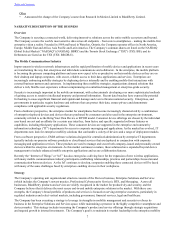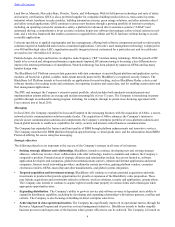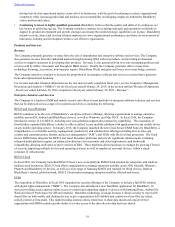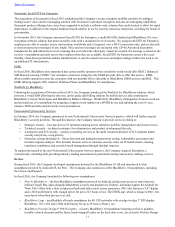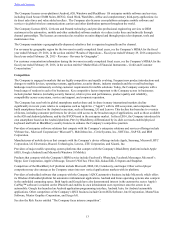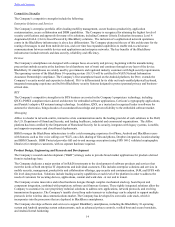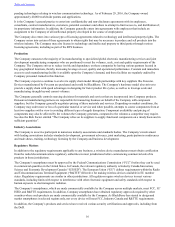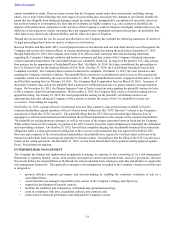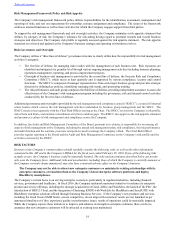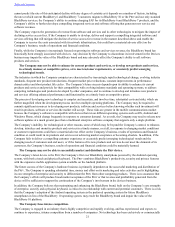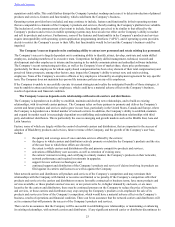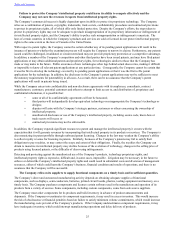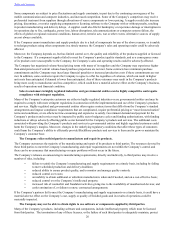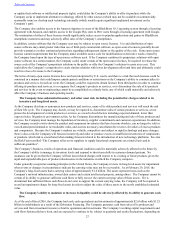Blackberry 2016 Annual Report Download - page 26
Download and view the complete annual report
Please find page 26 of the 2016 Blackberry annual report below. You can navigate through the pages in the report by either clicking on the pages listed below, or by using the keyword search tool below to find specific information within the annual report.
Table of Contents
17
Environmental Regulations and Costs
Some of the Company’s operations, principally in its Devices business, are subject to regulation under various provincial, state,
federal and international laws relating to environmental protection and the proliferation of hazardous substances. In parts of
Europe, North America, Asia-Pacific and Latin America, the Company is currently obligated to comply with substance
restrictions, packaging regulations, energy efficiency ratings and certain product take-back and recycling requirements. In
addition, the Company may be required to comply with emerging substance restrictions or energy efficiency requirements, as
well as product take-back obligations in other jurisdictions that would make the Company responsible for recycling and/or
disposing of products the Company has sold. These and other environmental laws may become more stringent over time, may
be required in more places of the Company’s business and may require the Company to incur substantial compliance costs.
Corporate Responsibility
The Company is committed to operating in a sustainable way that respects the environment, Company employees, the
communities in which the Company operates and the Company’s business partners around the world. Product sustainability
efforts include implementing design for environment principles, material selection processes, energy efficiency and packaging
assessments, as well as product take-back programs. In addition, the Company engages with its suppliers to conduct due
diligence into the source and chain of custody of the so-called “conflict minerals” (which currently include the minerals from
which gold, tantalum, tin, and tungsten are derived) that are necessary to the functionality or production of the Company’s
hardware products.
The Company has formalized a number of policies to reflect the Company’s commitment to responsible business practices,
including a Responsible Minerals Policy, and periodically issues a Corporate Responsibility report. This report and other
documents and policies relating to the Company’s corporate responsibility initiatives can be viewed on the Company’s website
at http://ca.blackberry.com/company/about-us/corporate-responsibility.html and are not incorporated by reference in this AIF.
Employees
As of February 29, 2016, the Company had 4,534 full-time employees.
Facilities
The Company’s headquarters are located in Waterloo, Ontario, Canada. The Company’s main campus in Waterloo consists of
three leased buildings. The Company also operates facilities in the United States, Latin America, Asia-Pacific, Europe, Middle
East and Africa.
LEGAL PROCEEDINGS
The Company is involved in litigation in the normal course of its business, both as a defendant and as a plaintiff. The Company
is subject to a variety of claims (including claims related to patent infringement, purported class actions and other claims in the
normal course of business) and may be subject to additional claims either directly or through indemnities against claims that it
provides to certain of its partners and customers. In particular, the industry in which the Company competes has many
participants that own, or claim to own, intellectual property, including participants that have been issued patents and may have
filed patent applications or may obtain additional patents and proprietary rights for technologies similar to those used by the
Company in its products. The Company has received, and may receive in the future, assertions and claims from third parties
that the Company’s products infringe on their patents or other intellectual property rights. Litigation has been, and will likely
continue to be, necessary to determine the scope, enforceability and validity of third-party proprietary rights or to establish the
Company’s proprietary rights. Regardless of whether claims against the Company have merit, those claims could be time-
consuming to evaluate and defend, result in costly litigation, divert management’s attention and resources, subject the Company
to significant liabilities and could have the other effects that are described in greater detail under “Risk Factors” in this AIF,
including the risk factors entitled “Litigation against the Company may result in adverse outcomes” and “The Company could
be found to have infringed on the intellectual property rights of others”.
Management reviews all of the relevant facts for each claim and applies judgment in evaluating the likelihood and, if
applicable, the amount of any potential loss. Where a potential loss is considered probable and the amount is reasonably
estimable, provisions for loss are made based on management’s assessment of the likely outcome. Where a range of loss can be
reasonably estimated with no best estimate in the range, the Company records the minimum amount in the range. The
Company does not provide for claims for which the outcome is not determinable or claims for which the amount of the loss
cannot be reasonably estimated. Any settlements or awards under such claims are provided for when reasonably determinable.
As of February 29, 2016, there are no claims outstanding for which the Company has assessed the potential loss as both
probable to result and reasonably estimable, therefore no accrual has been made. Further, there are claims outstanding for
which the Company has assessed the potential loss as reasonably possible to result, however an estimate of the amount of loss


